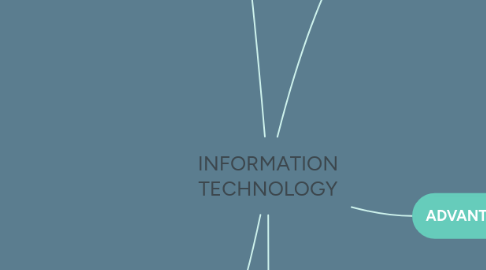
1. APPLICATIONS OF IT
1.1. Education
1.1.1. Learning Management System
1.1.1.1. Student can get their lecture note, answer quizzes and submit assingment by using LMS.
1.1.2. Computer-based training
1.1.2.1. Uses computer-generated visuals or environment for training such flight simulator.
1.2. Finance
1.2.1. Online banking
1.2.1.1. To pay bills, track personal income and expenses, manage investment and evaluate financial plans.
1.2.2. Finance Investment System
1.2.2.1. Inventores buy and sell stock and bond online without using broker.
1.3. Government
1.3.1. HRMIS
1.3.1.1. Online system for updating government employee information.
1.3.2. e-Filing
1.3.2.1. Online system for declaring tax.
1.3.3. e-Syariah
1.3.3.1. Online portal for prviding information about the rules and procedures of the court.
1.4. Health care
1.4.1. Medline
1.4.1.1. Many web sites provide up-to-date medical fitness, nutrition or exercise information.
1.4.2. Counter Registration System
1.4.2.1. Hospitals and doctors use computers and mobile devices to maintain and access patient record.
1.4.3. Telemedicine
1.4.3.1. Health care professionals in saparate locations conduct live conference in the computer.
1.5. Science
1.5.1. Virtual Reality
1.5.1.1. Use of computer to stimulate a real or imagined environment that appears as 3D space.
1.5.2. Hawk-Eye Officiating System
1.5.2.1. Track the path of an object that is being developed for use in sports.
1.6. Publishing
1.6.1. Online Newspaper/Magazine
1.6.1.1. Allow user to get information easily
1.6.2. Online Photo/Card Printing
1.6.2.1. Make our digital photos into professional photo print with quality designer photo papers.
1.7. Travel
1.7.1. GPS
1.7.1.1. Track routes for specific location.
1.7.2. E-ticketing
1.7.2.1. Online booking ticket.
1.8. Manufacturing
1.8.1. Computer-Aided Design(CAD)
1.8.1.1. Increase designer productivity and design quality.
1.8.2. Computer-Aided Manufacturing
1.8.2.1. Controls machine tools, mainly robot arms, in high tech assembly line. It use to speed up & improve accuracy of process for task.
2. CATEGORIES OF COMPUTERS
2.1. Supercomputers
2.1.1. Fastest and most powerful computer. Capable to process more than one quadrillion instructions in a single second.
2.1.2. Size
2.1.2.1. Occupy a full room of equipment.
2.2. Mainframes
2.2.1. Large, expensive, powerful computer that can handle hundreds or thousands of connected user simultaneously.
2.2.2. Size
2.2.2.1. Occupy partial room to a full room of equipment.
2.3. Personal Computers
2.3.1. A computer that can perform all of its input, processing, output and storage activity by itself.
2.3.2. Size
2.3.2.1. Fits on a desk.
2.4. Mobile Computers
2.4.1. Personal computer you can carry from place to place.
2.4.2. Size
2.4.2.1. Fits on your lap or in your hand.
2.4.3. Example
2.4.3.1. Notebook
2.4.3.2. Laptop
2.4.3.3. Netbook
2.4.3.4. Tablet PC
2.5. Mobile Devices
2.5.1. Computing device small enough to hold in your hand.
2.5.2. Size
2.5.2.1. Fits in the palm of your hand or a pocket size.
2.5.3. Example
2.5.3.1. Smartphones
2.5.3.2. PDAs
2.5.3.3. e-book
2.5.3.4. Digital cameras
2.6. Embedded Computers
2.6.1. Special purpose computer that is function as a component in a larger product.
2.6.2. Size
2.6.2.1. Miniature
2.6.3. Example
2.6.3.1. Anti lock brakes
2.6.3.2. Airbag controller
2.6.3.3. Printers
3. DEFINITION
3.1. Information technology or IT can be defined briefly as the use of computer hardware and software to store, retrieve and manipulate information.
4. ADVANTAGES
4.1. Speed
4.1.1. Many computers process billions or trillions of operations in a single second.
4.2. Reliability
4.2.1. The electronic components in computers are dependable and reliable because they rarely break or fail.
4.3. Consistency
4.3.1. A computer with the same input will produce the same results consistently.
4.4. Storage
4.4.1. Computers store enormous amount of data and make this data available for processing anytime it is needed.
4.5. Communications
4.5.1. Computers today can communicate wirelessly with other computers. this allow users to communicate with one another.
5. DISADVANTANGES
5.1. Health Risks
5.1.1. Prolonged or improper computer use can lead to health injuries.
5.1.2. Behavioral health risks are computer addiction and technology overload.
5.2. Violation of Privacy
5.2.1. Personal and confidential records stored on computers were not protected properly, individuals have found their privacy violated and identities stolen.
5.3. Public Safety
5.3.1. People use computers to share publicly their photos, videos and other personal information. They will be victim to crimes committed by dangerous strangers.
5.4. Impact on Labour Force
5.4.1. Computers have improved productivity. This will make computers replaced many labours.
5.5. Impact on Environment
5.5.1. Computer manufacturing processes and computer waste aree destroying natural resources and polluting the environment.

